Coral Reefs: Importance, Benefits, Threats and Protection Strategies
VerifiedAdded on 2022/10/19
|7
|1177
|99
Report
AI Summary
This report provides an overview of coral reefs, highlighting their crucial role in ocean life and the benefits they offer to both the environment and humans. It details the filtration capabilities of reefs, their contribution to marine biodiversity, and their economic value through fishing and tourism. The report then identifies significant threats to coral reefs, including pollution, coral bleaching due to climate change, and destructive fishing methods. It examines the causes of each threat and proposes various protection strategies, such as waste management, climate change mitigation, and the prohibition of harmful fishing practices. The report concludes by emphasizing the urgent need for implementing these strategies to preserve coral reefs and maintain the health of marine ecosystems. This assignment is a valuable resource for students studying environmental science, offering insights into the challenges facing coral reefs and potential solutions.

Running Head: REEFS
0
Coral reefs
student
7/26/2019
0
Coral reefs
student
7/26/2019
Paraphrase This Document
Need a fresh take? Get an instant paraphrase of this document with our AI Paraphraser
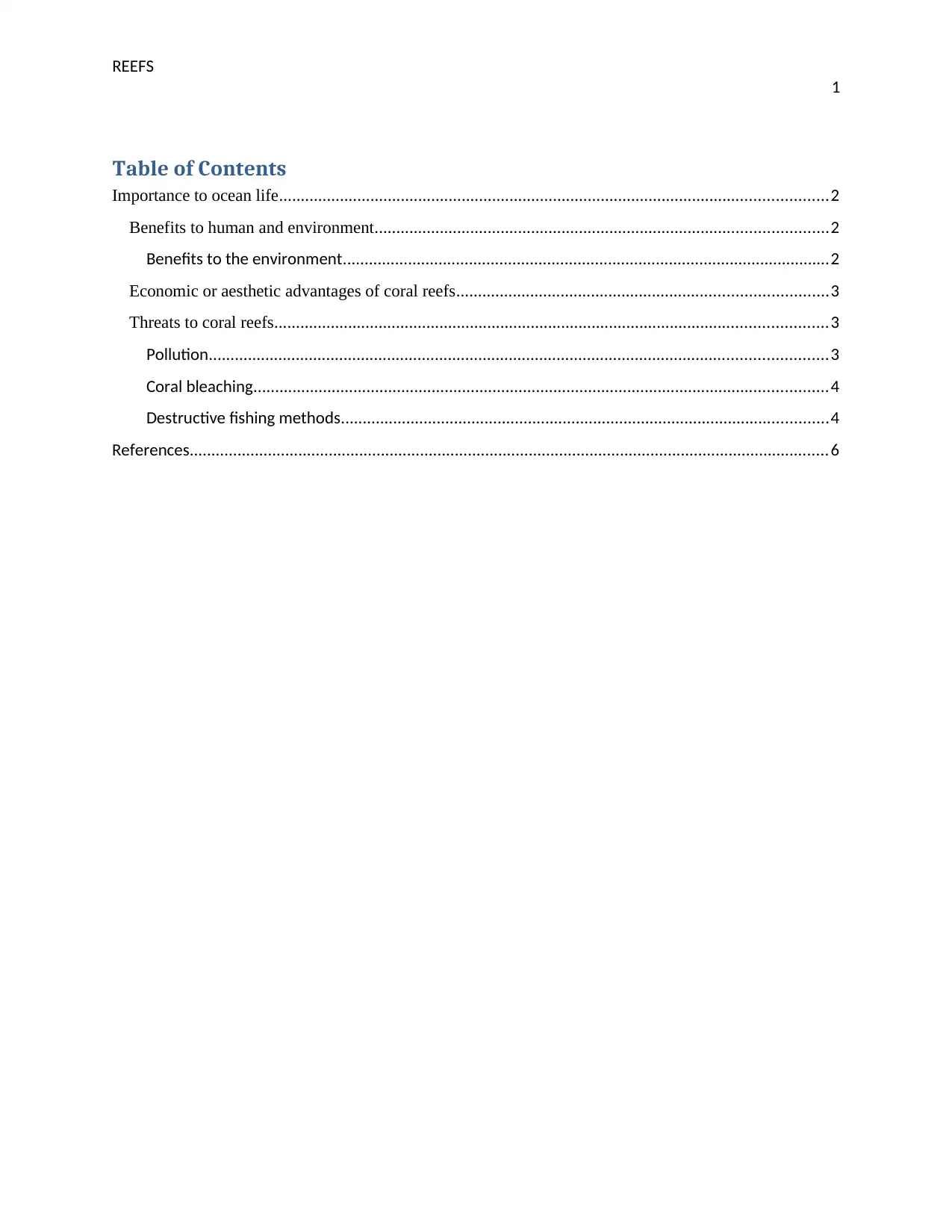
REEFS
1
Table of Contents
Importance to ocean life..............................................................................................................................2
Benefits to human and environment........................................................................................................2
Benefits to the environment................................................................................................................2
Economic or aesthetic advantages of coral reefs.....................................................................................3
Threats to coral reefs...............................................................................................................................3
Pollution..............................................................................................................................................3
Coral bleaching....................................................................................................................................4
Destructive fishing methods................................................................................................................4
References...................................................................................................................................................6
1
Table of Contents
Importance to ocean life..............................................................................................................................2
Benefits to human and environment........................................................................................................2
Benefits to the environment................................................................................................................2
Economic or aesthetic advantages of coral reefs.....................................................................................3
Threats to coral reefs...............................................................................................................................3
Pollution..............................................................................................................................................3
Coral bleaching....................................................................................................................................4
Destructive fishing methods................................................................................................................4
References...................................................................................................................................................6
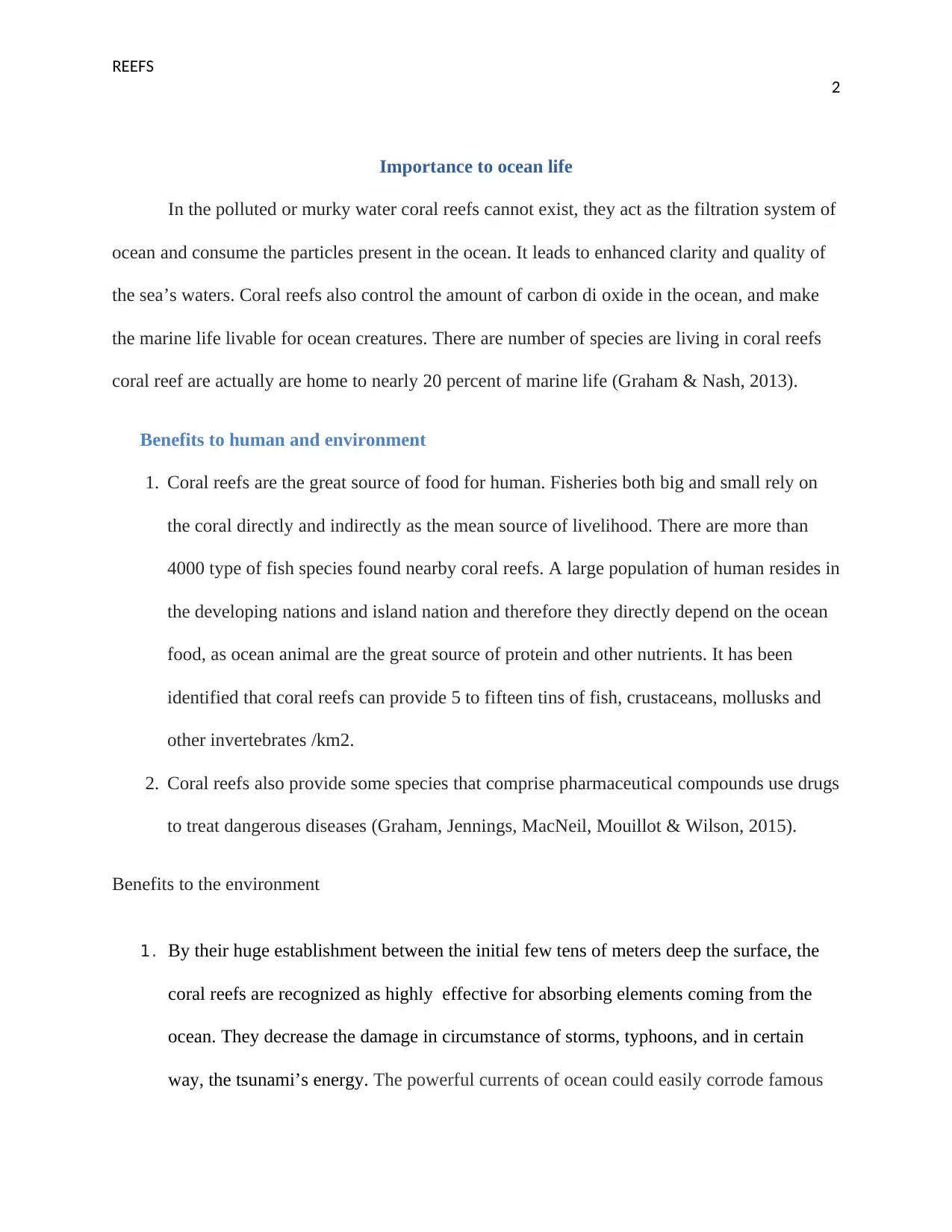
REEFS
2
Importance to ocean life
In the polluted or murky water coral reefs cannot exist, they act as the filtration system of
ocean and consume the particles present in the ocean. It leads to enhanced clarity and quality of
the sea’s waters. Coral reefs also control the amount of carbon di oxide in the ocean, and make
the marine life livable for ocean creatures. There are number of species are living in coral reefs
coral reef are actually are home to nearly 20 percent of marine life (Graham & Nash, 2013).
Benefits to human and environment
1. Coral reefs are the great source of food for human. Fisheries both big and small rely on
the coral directly and indirectly as the mean source of livelihood. There are more than
4000 type of fish species found nearby coral reefs. A large population of human resides in
the developing nations and island nation and therefore they directly depend on the ocean
food, as ocean animal are the great source of protein and other nutrients. It has been
identified that coral reefs can provide 5 to fifteen tins of fish, crustaceans, mollusks and
other invertebrates /km2.
2. Coral reefs also provide some species that comprise pharmaceutical compounds use drugs
to treat dangerous diseases (Graham, Jennings, MacNeil, Mouillot & Wilson, 2015).
Benefits to the environment
1. By their huge establishment between the initial few tens of meters deep the surface, the
coral reefs are recognized as highly effective for absorbing elements coming from the
ocean. They decrease the damage in circumstance of storms, typhoons, and in certain
way, the tsunami’s energy. The powerful currents of ocean could easily corrode famous
2
Importance to ocean life
In the polluted or murky water coral reefs cannot exist, they act as the filtration system of
ocean and consume the particles present in the ocean. It leads to enhanced clarity and quality of
the sea’s waters. Coral reefs also control the amount of carbon di oxide in the ocean, and make
the marine life livable for ocean creatures. There are number of species are living in coral reefs
coral reef are actually are home to nearly 20 percent of marine life (Graham & Nash, 2013).
Benefits to human and environment
1. Coral reefs are the great source of food for human. Fisheries both big and small rely on
the coral directly and indirectly as the mean source of livelihood. There are more than
4000 type of fish species found nearby coral reefs. A large population of human resides in
the developing nations and island nation and therefore they directly depend on the ocean
food, as ocean animal are the great source of protein and other nutrients. It has been
identified that coral reefs can provide 5 to fifteen tins of fish, crustaceans, mollusks and
other invertebrates /km2.
2. Coral reefs also provide some species that comprise pharmaceutical compounds use drugs
to treat dangerous diseases (Graham, Jennings, MacNeil, Mouillot & Wilson, 2015).
Benefits to the environment
1. By their huge establishment between the initial few tens of meters deep the surface, the
coral reefs are recognized as highly effective for absorbing elements coming from the
ocean. They decrease the damage in circumstance of storms, typhoons, and in certain
way, the tsunami’s energy. The powerful currents of ocean could easily corrode famous
⊘ This is a preview!⊘
Do you want full access?
Subscribe today to unlock all pages.

Trusted by 1+ million students worldwide
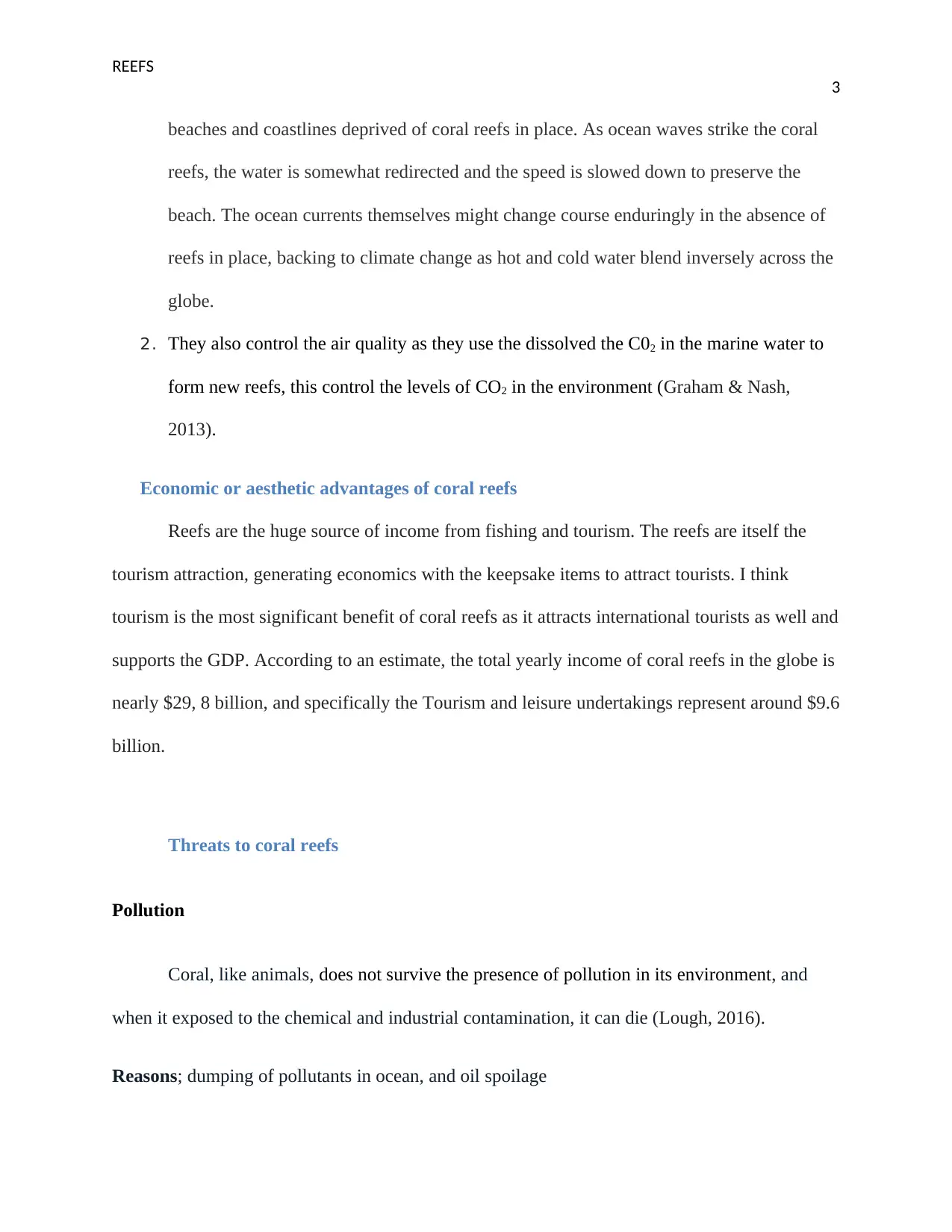
REEFS
3
beaches and coastlines deprived of coral reefs in place. As ocean waves strike the coral
reefs, the water is somewhat redirected and the speed is slowed down to preserve the
beach. The ocean currents themselves might change course enduringly in the absence of
reefs in place, backing to climate change as hot and cold water blend inversely across the
globe.
2. They also control the air quality as they use the dissolved the C02 in the marine water to
form new reefs, this control the levels of CO2 in the environment (Graham & Nash,
2013).
Economic or aesthetic advantages of coral reefs
Reefs are the huge source of income from fishing and tourism. The reefs are itself the
tourism attraction, generating economics with the keepsake items to attract tourists. I think
tourism is the most significant benefit of coral reefs as it attracts international tourists as well and
supports the GDP. According to an estimate, the total yearly income of coral reefs in the globe is
nearly $29, 8 billion, and specifically the Tourism and leisure undertakings represent around $9.6
billion.
Threats to coral reefs
Pollution
Coral, like animals, does not survive the presence of pollution in its environment, and
when it exposed to the chemical and industrial contamination, it can die (Lough, 2016).
Reasons; dumping of pollutants in ocean, and oil spoilage
3
beaches and coastlines deprived of coral reefs in place. As ocean waves strike the coral
reefs, the water is somewhat redirected and the speed is slowed down to preserve the
beach. The ocean currents themselves might change course enduringly in the absence of
reefs in place, backing to climate change as hot and cold water blend inversely across the
globe.
2. They also control the air quality as they use the dissolved the C02 in the marine water to
form new reefs, this control the levels of CO2 in the environment (Graham & Nash,
2013).
Economic or aesthetic advantages of coral reefs
Reefs are the huge source of income from fishing and tourism. The reefs are itself the
tourism attraction, generating economics with the keepsake items to attract tourists. I think
tourism is the most significant benefit of coral reefs as it attracts international tourists as well and
supports the GDP. According to an estimate, the total yearly income of coral reefs in the globe is
nearly $29, 8 billion, and specifically the Tourism and leisure undertakings represent around $9.6
billion.
Threats to coral reefs
Pollution
Coral, like animals, does not survive the presence of pollution in its environment, and
when it exposed to the chemical and industrial contamination, it can die (Lough, 2016).
Reasons; dumping of pollutants in ocean, and oil spoilage
Paraphrase This Document
Need a fresh take? Get an instant paraphrase of this document with our AI Paraphraser
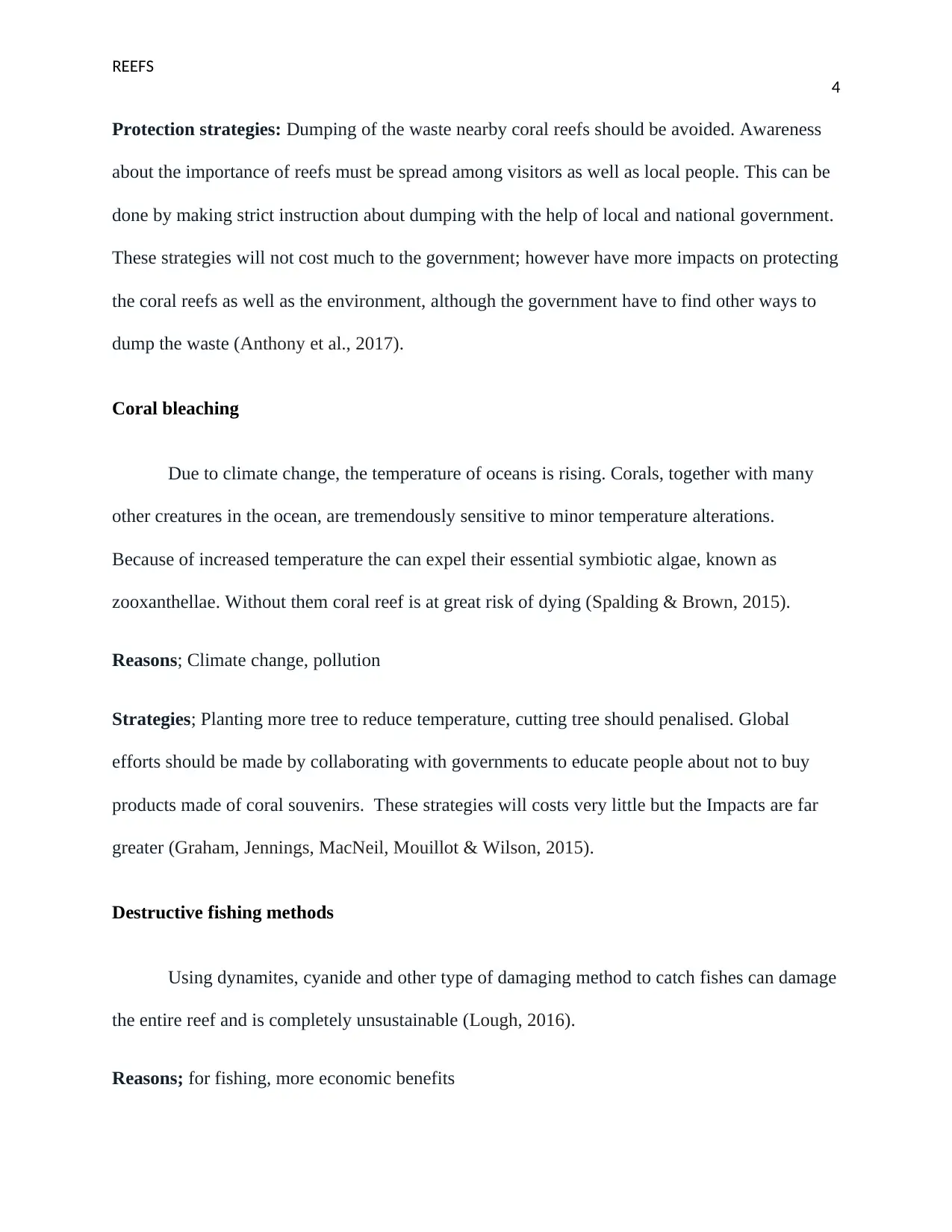
REEFS
4
Protection strategies: Dumping of the waste nearby coral reefs should be avoided. Awareness
about the importance of reefs must be spread among visitors as well as local people. This can be
done by making strict instruction about dumping with the help of local and national government.
These strategies will not cost much to the government; however have more impacts on protecting
the coral reefs as well as the environment, although the government have to find other ways to
dump the waste (Anthony et al., 2017).
Coral bleaching
Due to climate change, the temperature of oceans is rising. Corals, together with many
other creatures in the ocean, are tremendously sensitive to minor temperature alterations.
Because of increased temperature the can expel their essential symbiotic algae, known as
zooxanthellae. Without them coral reef is at great risk of dying (Spalding & Brown, 2015).
Reasons; Climate change, pollution
Strategies; Planting more tree to reduce temperature, cutting tree should penalised. Global
efforts should be made by collaborating with governments to educate people about not to buy
products made of coral souvenirs. These strategies will costs very little but the Impacts are far
greater (Graham, Jennings, MacNeil, Mouillot & Wilson, 2015).
Destructive fishing methods
Using dynamites, cyanide and other type of damaging method to catch fishes can damage
the entire reef and is completely unsustainable (Lough, 2016).
Reasons; for fishing, more economic benefits
4
Protection strategies: Dumping of the waste nearby coral reefs should be avoided. Awareness
about the importance of reefs must be spread among visitors as well as local people. This can be
done by making strict instruction about dumping with the help of local and national government.
These strategies will not cost much to the government; however have more impacts on protecting
the coral reefs as well as the environment, although the government have to find other ways to
dump the waste (Anthony et al., 2017).
Coral bleaching
Due to climate change, the temperature of oceans is rising. Corals, together with many
other creatures in the ocean, are tremendously sensitive to minor temperature alterations.
Because of increased temperature the can expel their essential symbiotic algae, known as
zooxanthellae. Without them coral reef is at great risk of dying (Spalding & Brown, 2015).
Reasons; Climate change, pollution
Strategies; Planting more tree to reduce temperature, cutting tree should penalised. Global
efforts should be made by collaborating with governments to educate people about not to buy
products made of coral souvenirs. These strategies will costs very little but the Impacts are far
greater (Graham, Jennings, MacNeil, Mouillot & Wilson, 2015).
Destructive fishing methods
Using dynamites, cyanide and other type of damaging method to catch fishes can damage
the entire reef and is completely unsustainable (Lough, 2016).
Reasons; for fishing, more economic benefits

REEFS
5
Strategies; Prohibiting fishing nearby coral reef and the people using explosives near the coral
reefs should be penalized and punished by the local government. This might reduce the
economic benefits of fishing but it must be implemented to save compete destruction of coral
reefs (Hoegh-Guldberg, Kennedy, Beyer, McClennen & Possingham, 2018).
5
Strategies; Prohibiting fishing nearby coral reef and the people using explosives near the coral
reefs should be penalized and punished by the local government. This might reduce the
economic benefits of fishing but it must be implemented to save compete destruction of coral
reefs (Hoegh-Guldberg, Kennedy, Beyer, McClennen & Possingham, 2018).
⊘ This is a preview!⊘
Do you want full access?
Subscribe today to unlock all pages.

Trusted by 1+ million students worldwide
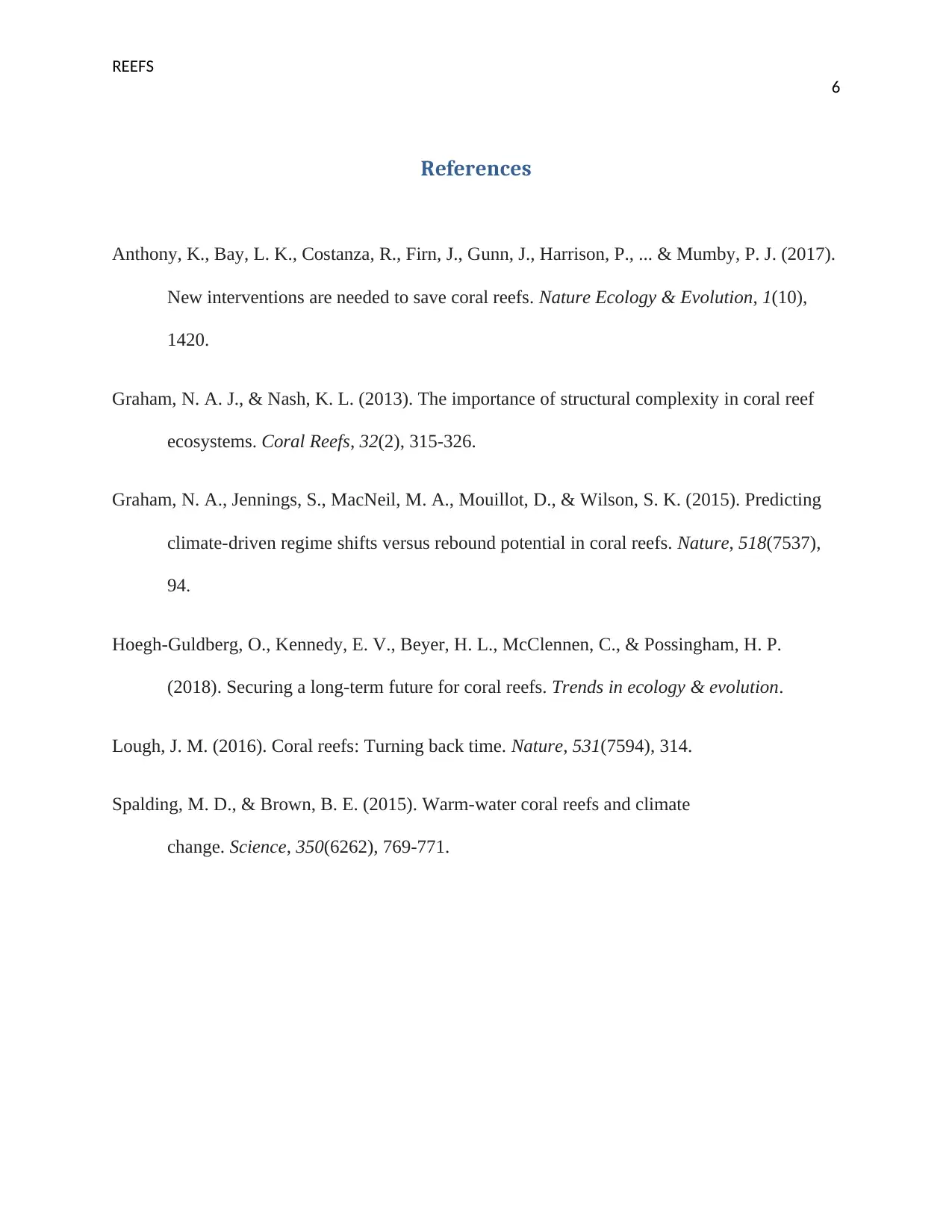
REEFS
6
References
Anthony, K., Bay, L. K., Costanza, R., Firn, J., Gunn, J., Harrison, P., ... & Mumby, P. J. (2017).
New interventions are needed to save coral reefs. Nature Ecology & Evolution, 1(10),
1420.
Graham, N. A. J., & Nash, K. L. (2013). The importance of structural complexity in coral reef
ecosystems. Coral Reefs, 32(2), 315-326.
Graham, N. A., Jennings, S., MacNeil, M. A., Mouillot, D., & Wilson, S. K. (2015). Predicting
climate-driven regime shifts versus rebound potential in coral reefs. Nature, 518(7537),
94.
Hoegh-Guldberg, O., Kennedy, E. V., Beyer, H. L., McClennen, C., & Possingham, H. P.
(2018). Securing a long-term future for coral reefs. Trends in ecology & evolution.
Lough, J. M. (2016). Coral reefs: Turning back time. Nature, 531(7594), 314.
Spalding, M. D., & Brown, B. E. (2015). Warm-water coral reefs and climate
change. Science, 350(6262), 769-771.
6
References
Anthony, K., Bay, L. K., Costanza, R., Firn, J., Gunn, J., Harrison, P., ... & Mumby, P. J. (2017).
New interventions are needed to save coral reefs. Nature Ecology & Evolution, 1(10),
1420.
Graham, N. A. J., & Nash, K. L. (2013). The importance of structural complexity in coral reef
ecosystems. Coral Reefs, 32(2), 315-326.
Graham, N. A., Jennings, S., MacNeil, M. A., Mouillot, D., & Wilson, S. K. (2015). Predicting
climate-driven regime shifts versus rebound potential in coral reefs. Nature, 518(7537),
94.
Hoegh-Guldberg, O., Kennedy, E. V., Beyer, H. L., McClennen, C., & Possingham, H. P.
(2018). Securing a long-term future for coral reefs. Trends in ecology & evolution.
Lough, J. M. (2016). Coral reefs: Turning back time. Nature, 531(7594), 314.
Spalding, M. D., & Brown, B. E. (2015). Warm-water coral reefs and climate
change. Science, 350(6262), 769-771.
1 out of 7
Related Documents
Your All-in-One AI-Powered Toolkit for Academic Success.
+13062052269
info@desklib.com
Available 24*7 on WhatsApp / Email
![[object Object]](/_next/static/media/star-bottom.7253800d.svg)
Unlock your academic potential
Copyright © 2020–2025 A2Z Services. All Rights Reserved. Developed and managed by ZUCOL.





